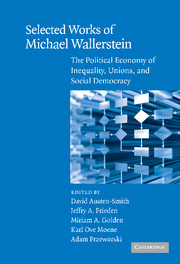 Selected Works of Michael Wallerstein
Selected Works of Michael Wallerstein Book contents
- Frontmatter
- Contents
- Preface and Acknowledgments
- 1 GENERAL INTRODUCTION
- Part I Class Conflict, the State, and Economic Limits to Democracy
- Part II The Politics of Labor Organizations
- 6 INTRODUCTION
- 7 UNION ORGANIZATION IN ADVANCED INDUSTRIAL DEMOCRACIES
- 8 CENTRALIZED BARGAINING AND WAGE RESTRAINT
- 9 POSTWAR TRADE-UNION ORGANIZATION AND INDUSTRIAL RELATIONS IN TWELVE COUNTRIES
- 10 UNIONS IN DECLINE? WHAT HAS CHANGED AND WHY
- Part III Inequality and Redistribution
- Part IV Labor and the Nordic Model of Social Democracy
- Other Books in the Series
- References
7 - UNION ORGANIZATION IN ADVANCED INDUSTRIAL DEMOCRACIES
Published online by Cambridge University Press: 27 January 2010
- Frontmatter
- Contents
- Preface and Acknowledgments
- 1 GENERAL INTRODUCTION
- Part I Class Conflict, the State, and Economic Limits to Democracy
- Part II The Politics of Labor Organizations
- 6 INTRODUCTION
- 7 UNION ORGANIZATION IN ADVANCED INDUSTRIAL DEMOCRACIES
- 8 CENTRALIZED BARGAINING AND WAGE RESTRAINT
- 9 POSTWAR TRADE-UNION ORGANIZATION AND INDUSTRIAL RELATIONS IN TWELVE COUNTRIES
- 10 UNIONS IN DECLINE? WHAT HAS CHANGED AND WHY
- Part III Inequality and Redistribution
- Part IV Labor and the Nordic Model of Social Democracy
- Other Books in the Series
- References
Summary
Few features of economic, social, or political life in industrialized democracies differ as much as the relative size of the trade union movement. The current density of union membership in the labor force ranges over almost the entire spectrum from above 90% in Sweden to under 20% in the United States (Goldfield 1987, 16). The level of unionization varies far more than such other characteristics of the labor force as the sectoral distribution of workers, the share of wages in GNP, rates of unemployment, or even the size of the public sector. Unionization rates vary more than such other forms of popular mobilization as electoral turnout or the share of the vote received by parties bearing communist, socialist, social democratic, or labor labels.
The economic effects of high levels of unionization are ambiguous. Unions that are large relative to the economy may simultaneously have more power in the labor market and more of an incentive to moderate their wage demands. A union that covers only a small fraction of an industry's work force, for example, can gain wage increases partly at the expense of employment among nonunion members, provided that union members have specialized skills not readily available elsewhere. In contrast, an industrial union covering the entire work force would be concerned with employment in all job categories. Bigger unions are not necessarily more militant unions (Cameron 1984; Olson 1982, chap. 4).
- Type
- Chapter
- Information
- Selected Works of Michael WallersteinThe Political Economy of Inequality, Unions, and Social Democracy, pp. 116 - 145Publisher: Cambridge University PressPrint publication year: 2008
